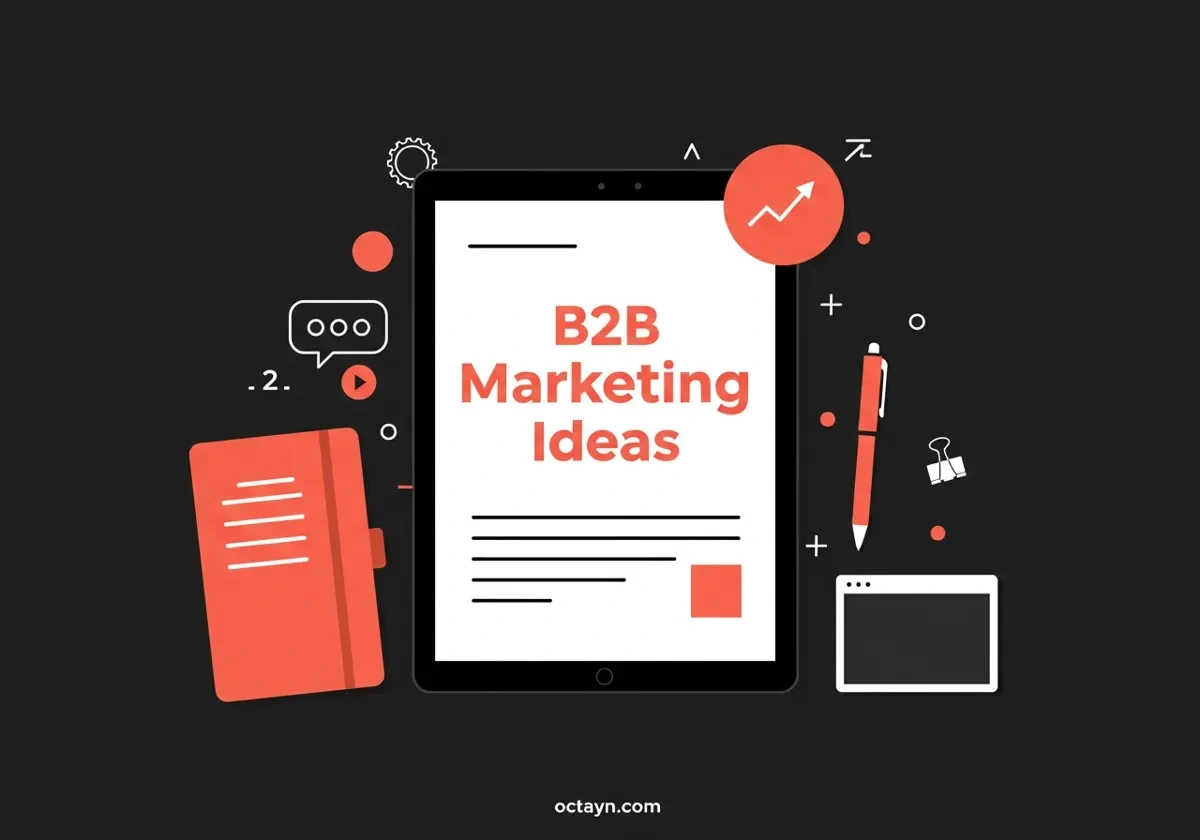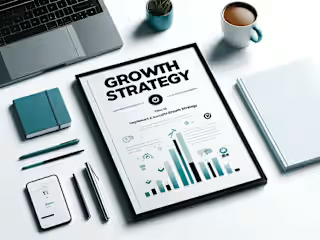9 Creative B2B Marketing Ideas to Stand Out in the SaaS Industry

The B2B SaaS landscape is more competitive than ever. As countless companies fight for attention, the usual marketing tactics can quickly blur together. If you want to stand out, you need more than standard strategies—you need creative, impactful ideas that resonate.
Imagine launching a campaign that stops your audience in its tracks, makes them curious, and drives them to engage. With the right creative approach, your marketing can leave a lasting impression and forge deeper connections. Personalized videos, interactive content, and unexpected collaborations grab attention and build genuine relationships.
This article covers nine powerful B2B marketing ideas to help your SaaS brand stand out. Whether a startup or established, these strategies offer fresh ways to attract, engage, and convert your ideal audience.
B2B Marketing Ideas: In Summary
Here’s a quick summary of what we cover in this guide:
Creative Outbound Email Campaigns capture attention with engaging story arcs or interactive elements.
Interactive Content engages users with tools like calculators and quizzes, showing real-time benefits and boosting conversions.
Personalized Video Marketing adds a human touch, with custom video messages that dramatically increase open and click-through rates.
Customer-Led Webinars showcase real success stories, building trust and generating conversions with authentic, relatable demonstrations.
User-Generated Content builds credibility, leveraging customer testimonials and feedback to inspire trust.
Virtual Workshops foster hands-on interaction, providing educational value while driving engagement and lead generation.
Strategic Partnerships with complementary brands expand reach, enhance credibility, and create co-marketing opportunities.
Social Media Challenges engage audiences through interactive campaigns that expand brand visibility.
Story-Driven Case Studies add depth to customer success stories, making the impact relatable and memorable.
Let’s get started and explore how to elevate your B2B marketing to new heights.
Idea #1: Outbound Email Campaigns with a Creative Twist
Outbound email campaigns can be effective in B2B marketing, but it’s easy for messages to get lost in crowded inboxes. A creative twist—like a story arc across multiple emails or interactive elements—can make your emails stand out. For example, instead of sending a traditional series of sales emails, you might create a “Choose Your Own Adventure” email sequence, where recipients click on different options to shape the next message they receive.
Adding creativity not only boosts engagement but also demonstrates that your brand is unique and willing to break the mold, setting you apart from the standard outreach methods.
Action Plan for Outbound Email Campaigns:
Craft an Engaging Story Arc: Design a series of emails that follow a story, with each email building on the last. Incorporate cliffhangers or interactive elements that make readers eager for the next one.
Personalize and Segment: Tailor email content based on recipient interests or industry to ensure relevance. This can include addressing specific pain points or incorporating personalized recommendations.
Add Interactive Elements: Experiment with formats like quizzes, polls, or even GIFs to keep the content lively and engaging. Use clickable links that allow recipients to “choose” the direction of the story.
Showing Impact: Monitor open rates, click-through rates, and conversion metrics from the campaign. Share customer testimonials or responses to the creative campaign, showcasing it as a successful example of innovative email marketing.
Idea #2: Personalized Video Marketing
In a text-heavy world, personalized videos can make your message stand out. Research shows that video emails boost open rates by 18% and click-throughs by 65%. Tailored videos show you understand each prospect’s unique needs, making your outreach more memorable.
Imagine sending a short video that introduces your company, acknowledges the prospect’s challenges, and shows how your SaaS product can help.
Videos personalize outreach and add a human touch, building rapport and trust. Tools like Loom, Vidyard, and Bonjoro let you quickly record, edit, and send videos.
Send personalized welcome videos to new leads, product walkthroughs for specific industries, or video responses to FAQs. This approach is especially effective in B2B SaaS, where complex products benefit from clear, customized explanations.
Action Plan:
Welcome New Leads with Video: Use Vidyard to send personalized videos that introduce your team and brand. Add a clear CTA for the next step, like scheduling a call or joining a demo.
Record Targeted Walkthroughs: For high-potential leads, create brief demos tailored to their needs or industry challenges. Show examples relevant to their sector.
Send Video FAQ Responses: Instead of a text FAQ page, record brief videos answering common questions. You could create a video library or send individual responses during the sales process.
Idea #3: Customer-Led Webinars
Traditional webinars often focus on a company’s leadership or product experts discussing features and benefits. But what if you invited your customers to take center stage instead?
Customer-led webinars allow your existing clients to share their success stories, giving prospects a first-hand account of your product’s impact. Prospective clients can see how others in similar roles or industries have benefited, making the potential ROI feel more real and attainable.
For instance, you might feature a customer who solved a common industry challenge using your SaaS tool, allowing them to discuss their journey, showcase results, and even answer audience questions. This format not only builds credibility but also fosters a sense of community around your brand.
Prospects see that you value your clients and are willing to let them share the spotlight, which can build trust and set your brand apart.
Action Plan:
Recruit Customer Advocates: Identify clients who are enthusiastic about your product and invite them to co-host a webinar where they share how they use your software to overcome challenges. Structure the session to show a live demo of their setup, guiding attendees through real use cases.
Host a “Customer Spotlight” Series: Create a recurring series where different clients showcase their unique processes. Each session could focus on a particular feature of your SaaS tool, demonstrated by real users for maximum authenticity.
Use Interactive Elements in the Webinar: During the session, use live polls, Q&A, or surveys to encourage audience engagement, making it more of a conversation than a presentation. Afterward, offer a downloadable guide summarizing key takeaways.
Idea #4: Leverage User-Generated Content (UGC) for Credibility
User-generated content (UGC) is an incredibly powerful way to showcase authentic customer experiences. In the B2B SaaS space, this could mean sharing user testimonials, reviews, or even inviting clients to submit stories, screenshots, or videos showing how they use your product. UGC gives prospective customers a real, relatable view of how your SaaS tool can impact their business, making your brand feel more accessible and trustworthy.
By consistently featuring UGC on your website, social media, or marketing materials, you show that your product isn’t just a promise—it’s a proven solution backed by real users. This approach not only builds credibility but also fosters community by recognizing and highlighting the people who drive your success.
Action Plan for UGC:
Run a Monthly “Customer of the Month” Campaign: Recognize a standout user by showcasing their story on your blog or social media. Include details of how they use the product, real screenshots, and any unique challenges they’ve overcome.
Create a Dedicated Testimonial Section on Your Site: Encourage satisfied clients to submit feedback through an easy form, and display a rotating gallery of quotes, reviews, and video testimonials.
Launch a Social Media Hashtag Challenge: Invite users to share their experiences with a unique hashtag (e.g., #OctaynImpact). Offer an incentive for participation, like a feature on your website or a chance to win a free consultation.
Showing Impact: Regularly track engagement metrics like shares, likes, and new leads attributed to UGC campaigns. Collect user feedback on these campaigns, and showcase success stories that resulted from UGC content.
Idea #5: Host Creative Virtual Workshops for Lead Generation
Virtual workshops offer a valuable way to connect with potential clients while providing educational content. Unlike webinars, which are more presentation-focused, workshops are hands-on and interactive, allowing participants to engage deeply with your product in real time. For instance, a SaaS company specializing in project management tools could host a workshop on “Streamlining Project Planning,” where attendees actively participate in setting up a real project using the software.
Workshops don’t just inform—they allow prospects to experience your product firsthand, see its capabilities, and envision how it could solve their problems. This direct engagement often leads to higher conversion rates, as attendees have already invested time and attention.
Action Plan for Virtual Workshops:
Pick Niche Topics with High Value: Identify common pain points among your target audience and build workshops around them, like “Reducing Lead Response Time with Automation” for CRM software.
Use Interactive Exercises: Design exercises that let attendees try features themselves, with guidance from a live facilitator. This approach encourages learning by doing and keeps the audience engaged.
Follow Up with Personalized Offers: After the workshop, send personalized follow-ups to attendees based on their level of interest and engagement, offering trial extensions, custom demos, or specific feature guides.
Showing Impact: Track participant numbers, engagement levels, and conversion rates post-workshop. Share attendee testimonials and create a summary of workshop outcomes, such as real feedback and notable success stories.
Idea #6: Build Unexpected Partnerships to Expand Reach
Strategic partnerships are highly effective for extending reach and credibility, with studies indicating that B2B co-marketing initiatives can result in a 50% boost in lead generation. For SaaS companies, partnerships with complementary tools or influencers can open new markets, elevate brand credibility, and create shared marketing opportunities.
For example, if your SaaS product specializes in email marketing automation, you might partner with a CRM platform for a joint webinar or blog series. These partnerships enhance credibility, broaden your reach, and create cross-promotional opportunities that benefit both parties.
Action Plan for Building Partnerships:
Identify Complementary Brands or Influencers: Make a list of companies with overlapping but non-competitive audiences. Contact them with a specific collaboration idea, like a joint e-book or webinar.
Create Content Together: Develop a co-branded white paper, case study, or tool comparison that showcases both brands’ unique contributions. Promote the content through each brand’s network for wider visibility.
Integrate Your SaaS Product with Partner Tools: If feasible, offer an integration with your partner’s tool to provide a seamless experience for users of both products. Promote the integration with an email campaign to each company’s user base.
Showing Impact: Measure reach, engagement, and lead generation from these partnerships. Collect metrics from joint campaigns, such as shared leads or social shares, and highlight successful partnerships in case studies or blog posts.
Idea #7: Social Media Challenges Tailored to B2B Audiences
Social media challenges are typically thought of as B2C marketing tactics, but they can be an effective way to engage B2B audiences as well—especially on platforms like LinkedIn. By creating a challenge relevant to your product or industry, you can generate user engagement and expand your reach. For example, if your SaaS product focuses on productivity, you could create a “5-Day Productivity Challenge,” where participants complete small, achievable tasks each day using your software.
Social media challenges are inherently interactive, and when structured well, they encourage participation and sharing, helping you reach new audiences organically. They also give prospects a chance to experience your product in action, building a sense of familiarity and trust.
Action Plan for Social Media Challenges:
Design a Relevant Challenge: Choose a challenge theme that aligns with your product, like “30 Days of Optimized Sales” for a CRM software. Set a timeline, create daily tasks, and guide participants on how to complete them using your product.
Create a Hashtag for Visibility: Develop a unique hashtag for the challenge, like #SaaSSalesChallenge, and encourage participants to share their progress using it. Monitor the hashtag for engagement and actively engage with users’ posts.
Incentivize Participation: Offer a prize or recognition for those who complete the challenge, like a feature on your blog or a free consultation.
Showing Impact: Track hashtag engagement, user participation, and new leads generated from the challenge. Compile highlights, testimonials, and results shared by participants to create a post-challenge success story.
Idea #8: Story-Driven Case Studies and Customer Success Stories
Case studies are already a staple in B2B marketing, but making them story-driven elevates their impact. Rather than simply listing results, a story-driven approach gives the case study a narrative arc, with a clear problem, a journey of overcoming obstacles, and a compelling resolution. Prospects can see themselves in the customer’s story, making the impact of your solution more relatable and memorable.
For instance, instead of just showing numbers, you could walk readers through the customer’s initial challenges, the steps they took with your SaaS product, and their growth journey. Infuse the case study with customer quotes, real data, and insights into how their business improved over time.
Action Plan for Story-Driven Case Studies:
Select Compelling Stories: Choose customers who had interesting or complex challenges. Conduct an in-depth interview to uncover their experiences, emotions, and insights.
Create a Narrative Arc: Write the case study with a beginning (the problem), middle (the journey), and end (the solution and results). Include real quotes and data to add authenticity.
Visualize Key Points: Use charts, infographics, and images to illustrate key achievements and milestones. Place these visuals in-line with the story to break up text and keep readers engaged.
Showing Impact: Track case study readership, time on page, and how often they’re referenced in sales conversations. Highlight successful case studies in your marketing and sales materials, using them as inspiration for prospects.
Idea #9: Interactive Content
Interactive content doesn’t just capture attention—it significantly boosts engagement and conversion rates. Research from Forbes shows that interactive content, like calculators and quizzes, generates nearly twice the engagement of static content and can increase conversion rates by up to 40%.
For example, a SaaS company offering financial tools could create a “Cost Savings Calculator.” Prospects enter their expenses to see how much they could save with your solution.
This approach engages your audience and shows the impact of your product. Interactive tools like these also work well for lead generation, as users often need to provide information or complete steps.
Ensure each interaction adds value. Offer insights, benchmarks, or recommendations so users see genuine benefits.
Action Plan:
Develop a Mini Assessment Tool: Make a short assessment (5-10 questions) to gauge business process maturity. Provide a score, improvement report, and a personalized follow-up offer.
Create a Cost-Savings Calculator: Build a calculator on your site where users input expenses and view potential savings. Include a CTA for demo requests.
Design an Industry Quiz: Create a quiz like “How Optimized is Your [Industry] Process?” with tailored recommendations. Use results to offer resources and link to product pages.
Conclusion
Standing out in the B2B SaaS space requires a mix of creativity and strategy. By going beyond traditional marketing tactics and focusing on unique, interactive approaches, you can engage prospects in memorable ways. Each of the ideas outlined—from interactive content and personalized video marketing to customer-led webinars and AR demos—shows potential clients exactly how your product can benefit their business, rather than simply telling them.
As you explore these creative tactics, remember that each interaction should reinforce your product’s value and build a stronger connection with your audience. By demonstrating your commitment to their success in authentic, actionable ways, you can transform leads into loyal customers who advocate for your brand. Now it’s time to implement these strategies, track the results, and watch your SaaS brand grow.
Further Reading:
Like this project
0
Posted Nov 11, 2024
Discover 10 creative B2B SaaS marketing ideas to captivate, engage, and convert your audience with impactful, experience-driven tactics.
Likes
0
Views
5





